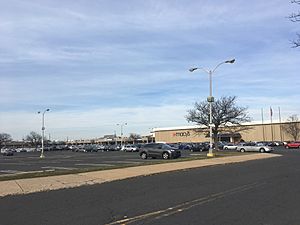Castor Gardens, Philadelphia facts for kids
Quick facts for kids
Castor Gardens
|
|
|---|---|

Castor Gardens is the location of Roosevelt Mall
|
|
| Country | |
| State | Pennsylvania |
| County | Philadelphia |
| City | Philadelphia |
| Area code(s) | 215, 267, and 445 |
Castor Gardens is a neighborhood in Philadelphia, Pennsylvania. It is located in the lower Northeast part of the city. The exact boundaries of Castor Gardens are not always clear. However, it is generally found around Castor Avenue and Cottman Avenue. It is also close to Roosevelt Boulevard.
You can enter the neighborhood from the south. Just take the Oxford Circle exit from Roosevelt Boulevard. Or, you can come from the north. Use the Cottman Avenue exit. Castor Gardens is next to other neighborhoods. These include Mayfair, Lawndale, Burholme, Oxford Circle, and Rhawnhurst. The neighborhood uses zip codes 19111 and 19149. Its physical borders are Pennway Street to the west, Roosevelt Boulevard to the east, Cottman Avenue to the north, and Van Kirk Avenue to the south.
Castor Gardens has important places for its residents. It is home to Roosevelt Mall, a large shopping center. There is also the Northeast Regional Library. This is a branch of the Free Library of Philadelphia. The city's District 10 Health Center is also located here.
Contents
What is the history of Castor Gardens?
The name Castor Gardens first referred to a group of homes. These were detached houses built north of Magee Avenue. They were on the east side of Whitaker Avenue. The name comes from Castor's mill. This mill was located near a creek. The creek is now hidden under the streets.
The homes in Castor Gardens were made of brick. They were considered nicer than the row homes nearby. These row homes were part of a neighborhood called Oxford Circle. Oxford Circle got its name from a traffic circle. This circle was where Oxford Avenue, Castor Avenue, and Roosevelt Boulevard met.
How did Castor Gardens grow?
As the area grew, more homes were built. The area between Magee and Cottman Avenue had many semi-detached and detached homes. To tell these homes apart from the older row homes, the name Castor Gardens became popular. This started in the 1950s.
People began to prefer the name Castor Gardens. So, the name started to cover a larger area. It first included newer row homes. Eventually, it covered the entire area once known as Oxford Circle. The name Oxford Circle then mostly referred to older, smaller homes. These were built in the 1920s and 1930s.
Homes in Castor Gardens were built starting in the 1930s. Construction paused during World War II. After the war, building picked up again. The last homes on streets near Cottman Avenue were finished in 1956. Some new homes are still built on individual lots today.
The Woodrow Wilson Junior High School is in Castor Gardens. It is now called Castor Gardens Middle School. This school was added to the National Register of Historic Places in 1986. This means it is an important historical building.
Who lives in Castor Gardens?
In the past, Castor Gardens was mainly a community of white, middle-class Jewish families. Over the last ten years, the neighborhood has become much more diverse. Many different groups of people now live here. These include people of Korean, Cambodian, Hispanic, Arab, African American, Chinese, Indian, and Brazilian backgrounds. This mix of cultures makes Castor Gardens a vibrant place to live.
Where can students learn in Castor Gardens?
Castor Gardens has good educational resources.
Schools in Castor Gardens
Castor Gardens Middle School is located at 1800 Cottman Avenue. It serves students in the neighborhood.
Public libraries in Castor Gardens
The Free Library of Philadelphia has two branches in Castor Gardens.
- The Bushrod Branch is at 6304 Castor Avenue. It is located at Stirling Street.
- The Northeast Regional Library is also part of the Free Library of Philadelphia. It is the largest library in Castor Gardens. You can find it at 2228 Cottman Avenue, at Oakland Street.

